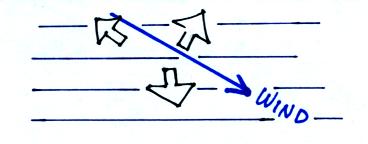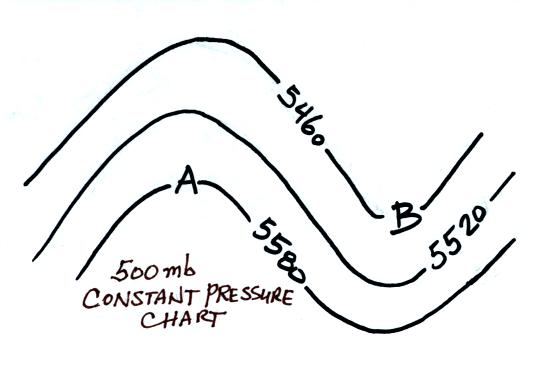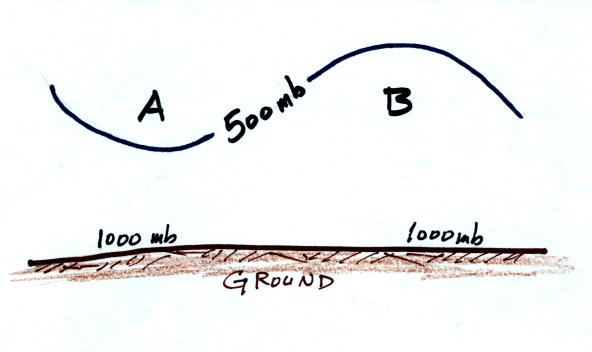Quiz
#4 Study Guide
Upper level charts
(see pps
115-119 in the photocopied notes).
Ridges
(warm air below) and troughs (cold air below). Winds blow parallel to
contour lines and from west to east.
Pressure decreases with increasing altitude in the
atmosphere. Does pressure decrease more quickly in warm or cold air,
in high or low density air? Are upper level conditions normally
displayed on constant altitude or constant pressure charts?
How does the pressure at point A in the
crossectional figure (right figure) compare with the pressure at Point
B? Is pressure
decreasing most rapidly with increasing altitude on the right or left
side of the figure? Is the coldest air
found on the right or left hand side of the figure?
What do the numbers on the contour lines on the constant pressure
(isobaric) map above at left represent? Is the coldest air
found in the north or
south? Is the air below Point A warmer or colder than
the air below Point B. Is Point A in a ridge or a trough?
Is this a northern or a southern hemisphere
chart? Is the pressure at Point A on the map higher, lower,
or the same as the pressure at Point B? How do the altitudes at the
two points compare?
***
Chapter 6 (pps 149-159) ***
Newton's 1st and 2nd laws of
motion. You should be able to state or
explain each law. Acceleration can be a change in speed and/or a
change in direction. Given a picture of an object's motion, you
should be able to determine whether a net force is acting on the
object or not. If a net force is present, you should have some idea
what direction it must point.
Forces that determine horizontal
winds. Pressure gradient force
(PGF), Coriolis force (CF), and frictional force (F) (surface winds
only).
Rules that determine the direction and strength of these forces.
Which force can start stationary air moving? Which of these forces
will only change the direction of the wind and not the wind speed?
Which one of these forces can only change the speed of the wind?
Upper level and surface winds. Upper
level winds blow parallel to the contours, surface winds cross the
isobars toward low pressure. Here are some
examples that you can study.
How do surface
winds blow around H and L
pressure centers in the northern and southern hemispheres?
Where do you find rising and sinking air motions?
Can
you identify the three forces acting on the wind in the
figure at right? Is this a southern or a northern
hemisphere chart? |

|
Sample Questions (from the
Quiz Packet)
Quiz #4: 2, 3, 11,
EC3? Quiz #5: 4, 5, 7, 12, 13,
EC2 Final Exam: 10, 13, 18, 26, 27
***
Chapter 7 (p.
172, pps 174-176,
184-189) ***
Thermal
circulations.
Land/sea breezes. Horizontal temperature differences
create an upper level pressure gradient (air pressure decreases at
different rates with increasing altitude in the warm and cold air).
Once upper level winds start to blow, a surface pressure gradient is
produced. You should be able to determine the directions of the surface
and upper level winds in the sketch below (the cloud is a clue). Would
you expect to find a
land or a sea breeze blowing at the surface? Where would the rising and
sinking air be found? Would you expect to see this circulation
during the day or at night?

In many ways the Indian monsoon resembles
a large scale thermal circulation. What does the term monsoon
mean?
One-cell model. Where
would the warmest and coldest locations on
the earth be found? Remembering that the one-cell model is just
a large scale thermal circulation, you would be able to show the
directions of the surface and upper level winds, and where
surface high and low pressure would be found.
Three-cell model. You
should know the locations of the following
features: ITCZ, equatorial low, horse latitudes, NE and SE trade
winds, subpolar low, polar front, doldrums, prevailing
westerlies, subtropical highs, polar highs, polar easterlies.
With which 3-cell model features might you expect to find
abundant or infrequent rainfall? Where are the following real
world features found (what feature in the three-cell model are
they associated with): Bermuda high, Aleutian low, Icelandic low,
and Pacific high?
Ocean currents. What directions do ocean currents flow
off the
east and west coasts of the US flow? Are these warm or cold
ocean currents. What feature in the 3-cell model causes these
currents? Knowing that, what directions would currents off the
east and west coasts (near 30 S latitude) of S. America flow?
Sample Questions
Quiz #5: 1, 3, 9, 15 Final Exam: 24, 46
***
Chapter 10 ***
Thunderstorms.
Ordinary single cell (air mass) and severe
thunderstorms (what would make a thunderstorm severe).
Thunderstorm occurrence (see Fig. 10.18). Life cycle of an air
mass thunderstorm. How can the dissipation of one storm lead to
the formation of another? Thunderstorm features and, in some
cases, processes that produce them: gust front, anvil cloud,
shelf cloud, mammatus clouds, microburst. Wind shear. Why can a
storm with a tilted updraft become stronger and last longer than
a storm with a vertical updraft? Supercell thunderstorms.
Tornadoes. General
characteristics: low pressure core, duration,
length of path on the ground, diameter, speed of rotating winds,
speed and usual direction of the movement on the ground. Life
cycle. What causes the tornado cloud? Tornado season (when do
the most tornadoes occur, when do the strongest tornadoes occur).
Fujita scale. Tornado winds and damage. Multiple vortices,
suction vortices. Mesocyclone and wall clouds. Tornado watches
and warnings. Hook echo on radar. Doppler radar - what
additional information does it provide that an ordinary radar
does not?
Lightning. What
creates the
electricity in thunderstorms?
Normal distribution of electrical charge in a thunderstorm.
Intracloud and cloud-to-ground lightning. Sequence of events in
a multi-stroke cloud-to-ground lightning flash: stepped leader,
upward connecting discharge, first return stroke, one or more
dart leaders and subsequent return strokes. Unusual types of
lightning and rocket-triggered lightning. Lightning hazards and
safety. What produces thunder? Determining the distance to a
lightning strike. How/why do lightning rods and cars offer
protection from
lightning?
Sample Questions
Quiz #6: 1-5, 7-11, 12?, 13-16, EC1, EC2? Final Exam: 4,
33a, 39, 51
Reviews (be sure to read this warning concerning the reviews)
Mon., Nov. 26
|
4-5 pm
|
SocSci 222
|
Tue., Nov. 27
|
4-5 pm
|
FCS 225
|
Wed., Nov. 28
|
4-5 pm
|
FCS 225 |
Note the MWF class quiz is on Wednesday Nov. 28 (the Wed. afternoon
review is for the T Th class)





